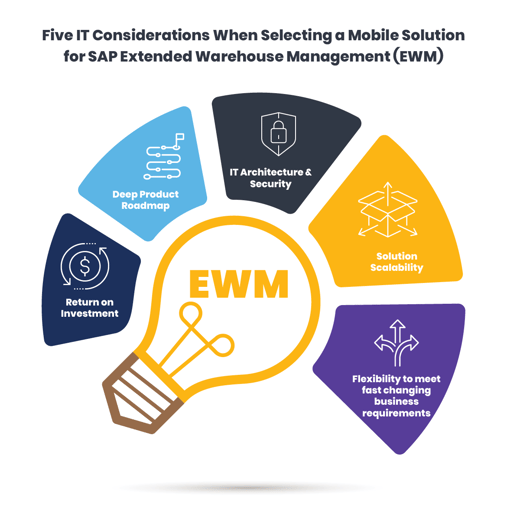5 IT Considerations When Selecting a Mobile Solution for SAP Extended Warehouse Management (EWM)

Warehouse operations are evolving rapidly, driven by rising customer demands for shorter lead times, a broader product range, and omni-channel distribution. To stay competitive, companies are reshaping their supply chains with smaller, more localized warehouses and faster fulfillment processes. This transformation has intensified the pressure on IT departments, especially as many organizations transition to SAP S/4HANA and implement Extended Warehouse Management (EWM) solutions.
For companies adopting EWM, selecting the right mobile solution is critical to success. The right mobile solution can help businesses improve productivity, streamline workflows, and optimize warehouse operations.
Below are five IT considerations when choosing a mobile solution for SAP EWM:

1. Flexibility to Adapt to Changing Business Requirements
The dynamic nature of supply chains demands flexibility. SAP EWM offers robust features such as cross-docking, two-step picking, and task interleaving. However, the challenge lies in how to easily deliver these features to end-users on mobile devices. Older SAP solutions, such as ITS Mobile or Fiori apps, lack the flexibility needed for modern warehouses. They rely on browser-based interfaces, which may slow down performance and hinder adaptability to new processes.
A modern mobile solution must be flexible, allowing rapid adjustments to meet evolving business needs. Mobile apps that are no-code or low-code configurable can reduce deployment time, offering businesses greater agility.
2. Scalability of Mobile Solutions
Many businesses initially built custom mobile solutions for warehouses, but these often proved costly and hard to scale. As warehouse operations expand globally, solutions that worked in one region may not suit others due to differences in process requirements and language localization. Scaling such systems can involve significant delays and high maintenance costs.
A scalable mobile solution should provide out-of-the-box functionality that can be easily customized for various warehouse setups. No-code platforms simplify this process, allowing IT teams to make changes without relying on external developers. When evaluating a mobile solution, scalability should be a top criterion.
3. Robust IT Architecture and Security
Security is paramount when integrating mobile solutions with corporate SAP systems. IT teams need to ensure that the mobile solution adheres to strict security protocols. Key considerations include:
- Authentication mechanisms for secure logins.
- Secure data handling, both on-device and in the cloud.
- Offline capabilities to maintain warehouse productivity in areas with poor Wi-Fi coverage.
A mobile solution should also integrate seamlessly with cloud infrastructure and be SAP-certified to ensure compliance with the company’s security standards.
4. Deep Product Roadmap and Future-Proofing
The pace of technological innovation is accelerating. In the future, warehouse operations will increasingly rely on emerging technologies like AI, wearables, RFID, and vision picking. A future-proof mobile solution should have a clear and evolving product roadmap that incorporates these innovations.
Companies should evaluate whether the mobile solution provider offers regular updates that align with SAP’s releases and supports features like predictive analytics and real-time tracking. A solution with a comprehensive roadmap will ensure businesses can leverage new technologies without significant overhauls.
5. Return on Investment (ROI)
Every IT investment must deliver a clear ROI. While custom-built mobile solutions may appear cost-effective in the short term, they often result in higher long-term costs due to maintenance, upgrades, and lack of flexibility. Companies should evaluate not only the initial costs but also the total cost of ownership (TCO) when selecting a mobile solution.
Beyond cost, consider how the solution enhances warehouse productivity. Features like optical character recognition (OCR) and intuitive user interfaces can reduce the time required to complete tasks and minimize errors, further driving ROI.
Selecting the right mobile solution for SAP Extended Warehouse Management is essential for optimizing warehouse operations. When evaluating mobile solutions, businesses must prioritize flexibility, scalability, security, future-proofing, and ROI to ensure long-term success.
Ready to enhance your warehouse productivity with the right mobile solution? Schedule a demo today to explore cutting-edge solutions for SAP EWM.

See It In Action
Schedule a personalized demo to see how our solutions can help your business thrive.
- 29-09-2025
Your Ultimate Guide to Connected Worker
In the rapidly evolving industrial landscape, maximizing plant efficiency and ensuring optimal...
- 20-08-2025
Building the future of Industrial Operations with Innovapptive and AWS
Most manufacturers have already gone digital. Yet business outcomes haven’t moved in step. Many...
- 22-04-2025
The $3.6B Unlock: Solving the Chemical Industry’s Labor Crisis and EBITDA Pressure in One Move
“Constraints don’t slow innovation—they force it.”


